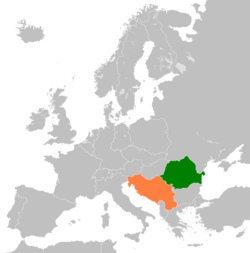Romania–Yugoslavia relations
Romania |
Yugoslavia |
|---|---|
 | |
Romania |
Yugoslavia |
|---|---|
Romania |
Yugoslavia |
|---|---|
Romania–Yugoslavia relations were historical foreign relations between Romania (both Kingdom of Romania 1918-1947 and the People's or Socialist Republic of Romania 1947–1989) and now broken up Yugoslavia (Kingdom of Yugoslavia 1918-1941 and Socialist Federal Republic of Yugoslavia 1945–1992). Relations between Romania and independent South Slavic states (primarily Serbia) developed before creation of Yugoslavia and union of Transylvania with Romania and those relations played prominent role during the Second Balkan War. Relations between the two states were generally friendly and were only occasionally affected by wider alliance policies.
History
Interwar period

After the dissolution of Austria-Hungary both Romania and Yugoslavia established and cooperated in the framework of the Little Entente and the Balkan Pact.
World War II
During the
Cold War period

Following the 1948 Tito–Stalin split close relations with all Eastern Bloc countries, including Romania, were either suspended or significantly strained. The relations between Romania and Yugoslavia were particularly tense over the issue of navigation on the Danube river where East Bloc its earlier favorable position.[2]
Following the
-
Nicolae Ceaușescu, Josip Broz Tito, Jovanka Broz and other participants at the Romanian-Yugoslav friendship meeting in Bucharest.
-
Yugoslav–Romanian talks in 1974 in Bucharest
-
Romanian party delegation visit to Belgrade in 1963
-
Signing of the Joint Communiqué
-
Josip Vrhovec and Nicolae Ceaușescu
Breakup of Yugoslavia
When the
See also
- Foreign relations of Romania
- Foreign relations of Yugoslavia
- Group of Nine
- Foreign relations of Bosnia and Herzegovina, Croatia, Montenegro, North Macedonia, Serbia and Slovenia
- Relations between Romania and Slovenia
References
- ^ S2CID 144890347. Retrieved 25 December 2020.
- ^ Tuluş, Arthur (2015). "The Tito-Stalin Conflict and its Political Consequences over the International Regime of the Danube River". Acta Universitatis Danubius. Relationes Internationales (8:1). Retrieved 25 December 2020.
- ^ Sitariu, Mihaela (2013). British-Romanian Relations during the Cold War (Doctoral Thesis). University of Western Ontario. Retrieved 25 December 2020.
- ISBN 978-953-313-750-6.
- ^ a b Nikolaos, Tzifakis (2001). "The Yugoslav Wars' Implications on Romanian Security" (PDF). Southeast European Politics (2:1): 46–58. Retrieved 25 December 2020.
- ^ "A chronology of Romania – NATO relationship". Ministry of Foreign Affairs (Romania). Retrieved 25 December 2020.








